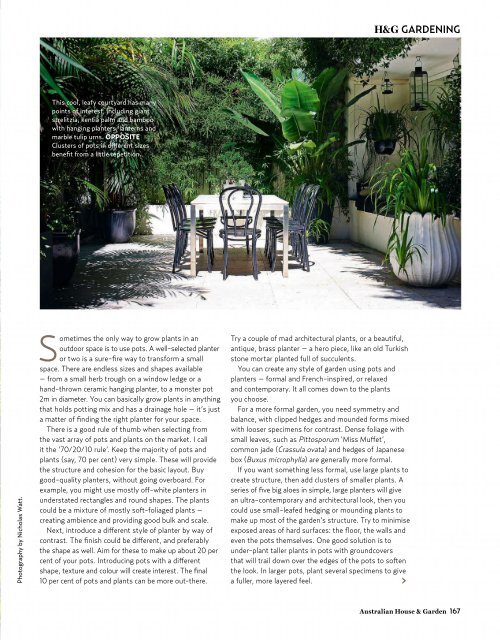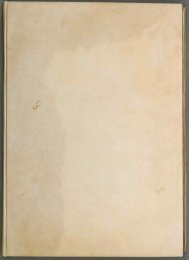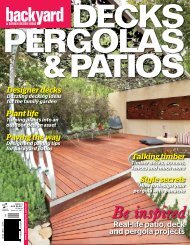REVELATIONS
Create successful ePaper yourself
Turn your PDF publications into a flip-book with our unique Google optimized e-Paper software.
H&G GARDENING<br />
This cool, leafy courtyard has many<br />
points of interest, including giant<br />
strelitzia, kentia palm and bamboo<br />
with hanging planters, lanterns and<br />
marble tulip urns. OPPOSITE<br />
Clusters of pots in different sizes<br />
benefit from a little repetition.<br />
Photography by Nicholas Watt.<br />
Sometimes the only way to grow plants in an<br />
outdoor space is to use pots. A well-selected planter<br />
or two is a sure-fire way to transform a small<br />
space. There are endless sizes and shapes available<br />
– from a small herb trough on a window ledge or a<br />
hand-thrown ceramic hanging planter, to a monster pot<br />
2m in diameter. You can basically grow plants in anything<br />
that holds potting mix and has a drainage hole – it’s just<br />
a matter of finding the right planter for your space.<br />
There is a good rule of thumb when selecting from<br />
the vast array of pots and plants on the market. I call<br />
it the ‘70/20/10 rule’. Keep the majority of pots and<br />
plants (say, 70 per cent) very simple. These will provide<br />
the structure and cohesion for the basic layout. Buy<br />
good-quality planters, without going overboard. For<br />
example, you might use mostly off-white planters in<br />
understated rectangles and round shapes. The plants<br />
could be a mixture of mostly soft-foliaged plants –<br />
creating ambience and providing good bulk and scale.<br />
Next, introduce a different style of planter by way of<br />
contrast. The finish could be different, and preferably<br />
the shape as well. Aim for these to make up about 20 per<br />
cent of your pots. Introducing pots with a different<br />
shape, texture and colour will create interest. The final<br />
10 per cent of pots and plants can be more out-there.<br />
Try a couple of mad architectural plants, or a beautiful,<br />
antique, brass planter – a hero piece, like an old Turkish<br />
stone mortar planted full of succulents.<br />
You can create any style of garden using pots and<br />
planters – formal and French-inspired, or relaxed<br />
and contemporary. It all comes down to the plants<br />
you choose.<br />
For a more formal garden, you need symmetry and<br />
balance, with clipped hedges and mounded forms mixed<br />
with looser specimens for contrast. Dense foliage with<br />
small leaves, such as Pittosporum ‘Miss Muffet’,<br />
common jade (Crassula ovata) and hedges of Japanese<br />
box (Buxus microphylla) are generally more formal.<br />
If you want something less formal, use large plants to<br />
create structure, then add clusters of smaller plants. A<br />
series of five big aloes in simple, large planters will give<br />
an ultra-contemporary and architectural look, then you<br />
could use small-leafed hedging or mounding plants to<br />
make up most of the garden’s structure. Try to minimise<br />
exposed areas of hard surfaces: the floor, the walls and<br />
even the pots themselves. One good solution is to<br />
under-plant taller plants in pots with groundcovers<br />
that will trail down over the edges of the pots to soften<br />
the look. In larger pots, plant several specimens to give<br />
a fuller, more layered feel. ><br />
Australian House & Garden 167








